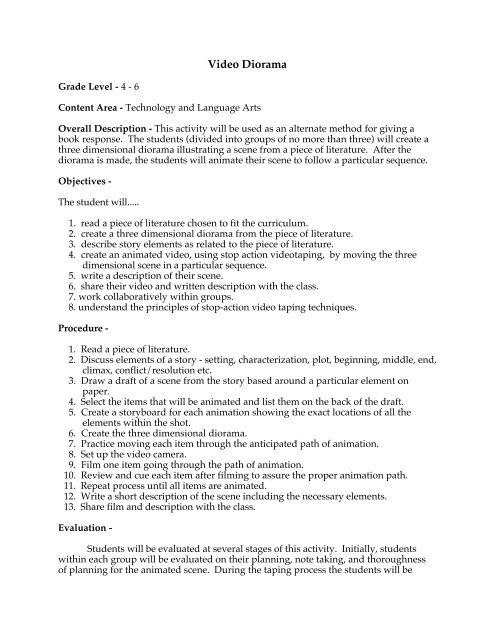Video Diorama
Video Diorama
Video Diorama
Create successful ePaper yourself
Turn your PDF publications into a flip-book with our unique Google optimized e-Paper software.
Grade Level - 4 - 6<br />
<strong>Video</strong> <strong>Diorama</strong><br />
Content Area - Technology and Language Arts<br />
Overall Description - This activity will be used as an alternate method for giving a<br />
book response. The students (divided into groups of no more than three) will create a<br />
three dimensional diorama illustrating a scene from a piece of literature. After the<br />
diorama is made, the students will animate their scene to follow a particular sequence.<br />
Objectives -<br />
The student will.....<br />
1. read a piece of literature chosen to fit the curriculum.<br />
2. create a three dimensional diorama from the piece of literature.<br />
3. describe story elements as related to the piece of literature.<br />
4. create an animated video, using stop action videotaping, by moving the three<br />
dimensional scene in a particular sequence.<br />
5. write a description of their scene.<br />
6. share their video and written description with the class.<br />
7. work collaboratively within groups.<br />
8. understand the principles of stop-action video taping techniques.<br />
Procedure -<br />
1. Read a piece of literature.<br />
2. Discuss elements of a story - setting, characterization, plot, beginning, middle, end,<br />
climax, conflict/resolution etc.<br />
3. Draw a draft of a scene from the story based around a particular element on<br />
paper.<br />
4. Select the items that will be animated and list them on the back of the draft.<br />
5. Create a storyboard for each animation showing the exact locations of all the<br />
elements within the shot.<br />
6. Create the three dimensional diorama.<br />
7. Practice moving each item through the anticipated path of animation.<br />
8. Set up the video camera.<br />
9. Film one item going through the path of animation.<br />
10. Review and cue each item after filming to assure the proper animation path.<br />
11. Repeat process until all items are animated.<br />
12. Write a short description of the scene including the necessary elements.<br />
13. Share film and description with the class.<br />
Evaluation -<br />
Students will be evaluated at several stages of this activity. Initially, students<br />
within each group will be evaluated on their planning, note taking, and thoroughness<br />
of planning for the animated scene. During the taping process the students will be
evaluated on their attention to detail and the degree to which the animated scene<br />
relates to the particular tory element they are trying to portray. Finally, the students<br />
will be evaluated (both by the instructor and their peers) on the quality of the video<br />
taped animation.
















